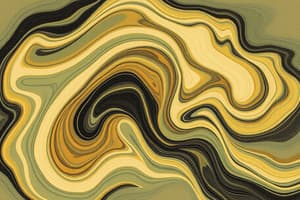Podcast
Questions and Answers
What is a key characteristic of the Lagrangian description of fluid motion?
What is a key characteristic of the Lagrangian description of fluid motion?
- It describes properties as functions of space only.
- It focuses on the forces acting on the fluid.
- It tracks individual fluid particles over time. (correct)
- It observes properties at fixed points in space.
In the context of fluid mechanics, what defines the Eulerian approach?
In the context of fluid mechanics, what defines the Eulerian approach?
- Analyzing the individual motion of fluid particles.
- Calculating the forces acting on the fluid.
- Tracking fluid particles based on their initial position.
- Observing the flow at specific locations and times. (correct)
Which statement best describes fluid kinematics?
Which statement best describes fluid kinematics?
- It calculates the rates of energy transfer in fluids.
- It describes pressure changes within a fluid.
- It involves analyzing the forces acting on fluid motion.
- It focuses only on the motion of fluids without considering forces. (correct)
What does the Reynolds Transport Theorem help to calculate?
What does the Reynolds Transport Theorem help to calculate?
Which of the following best describes streaklines in fluid flow?
Which of the following best describes streaklines in fluid flow?
What characterizes steady flow in fluid dynamics?
What characterizes steady flow in fluid dynamics?
Which type of flow is characterized by fluid properties that are functions of time?
Which type of flow is characterized by fluid properties that are functions of time?
How can unsteady flows be categorized?
How can unsteady flows be categorized?
Which of the following best describes a streamline?
Which of the following best describes a streamline?
What visualization technique joins all present locations of fluid particles that have passed through a specific point?
What visualization technique joins all present locations of fluid particles that have passed through a specific point?
In which dimensional flow does velocity not change with one or two of the space coordinates?
In which dimensional flow does velocity not change with one or two of the space coordinates?
Which of the following statements is true regarding flow visualization?
Which of the following statements is true regarding flow visualization?
In steady flow, streaklines, pathlines, and streamlines will:
In steady flow, streaklines, pathlines, and streamlines will:
What is the net rate of increase of the algae population per minute?
What is the net rate of increase of the algae population per minute?
In the Eulerian description, what does the velocity at a point represent?
In the Eulerian description, what does the velocity at a point represent?
How is the acceleration vector field of the flow expressed using Newton’s second law?
How is the acceleration vector field of the flow expressed using Newton’s second law?
What is the 'total acceleration' at a point derived from in the Eulerian framework?
What is the 'total acceleration' at a point derived from in the Eulerian framework?
Which mathematical principle is used to obtain the scalar time derivatives in the Eulerian description?
Which mathematical principle is used to obtain the scalar time derivatives in the Eulerian description?
What principle does flow continuity express regarding mass in a flow section?
What principle does flow continuity express regarding mass in a flow section?
Which equation is used to describe the relationship between fluid density, cross-sectional area, and fluid velocity at two points?
Which equation is used to describe the relationship between fluid density, cross-sectional area, and fluid velocity at two points?
How is the flux of a scalar concentration, such as sediment, calculated?
How is the flux of a scalar concentration, such as sediment, calculated?
What does a control volume focus on in fluid mechanics?
What does a control volume focus on in fluid mechanics?
What does the Reynolds Transport Theorem primarily deal with?
What does the Reynolds Transport Theorem primarily deal with?
In the conservation of mass, what is true about a closed system over time?
In the conservation of mass, what is true about a closed system over time?
Which of the following represents an example of a scalar concentration carried by fluid flow?
Which of the following represents an example of a scalar concentration carried by fluid flow?
What defines the rate of change of momentum in a system according to fluid mechanics?
What defines the rate of change of momentum in a system according to fluid mechanics?
What does dBsys/dt represent in the context provided?
What does dBsys/dt represent in the context provided?
In the context of Reynolds Transport Theorem, what happens to the first term on the right-hand side during steady flow problems?
In the context of Reynolds Transport Theorem, what happens to the first term on the right-hand side during steady flow problems?
When analyzing a fixed control volume with multiple boundary sections, what determines the change in a property of the system?
When analyzing a fixed control volume with multiple boundary sections, what determines the change in a property of the system?
For a system at time t = 1:30 pm with 50,000 m³ of water, which property is primarily being analyzed?
For a system at time t = 1:30 pm with 50,000 m³ of water, which property is primarily being analyzed?
In the expression given, what does the variable β represent?
In the expression given, what does the variable β represent?
What does the differential form of the control volume equation provide regarding the extensive property B?
What does the differential form of the control volume equation provide regarding the extensive property B?
Which equation describes the rate of change of the extensive property B across the control volume?
Which equation describes the rate of change of the extensive property B across the control volume?
How can the rate of change of energy of the system in a fixed control volume be calculated?
How can the rate of change of energy of the system in a fixed control volume be calculated?
What does the volume flow rate (Q) measure?
What does the volume flow rate (Q) measure?
If the fluid flow area (A) is increased while keeping the velocity (U) constant, what happens to the volumetric flow rate (Q)?
If the fluid flow area (A) is increased while keeping the velocity (U) constant, what happens to the volumetric flow rate (Q)?
Which equation correctly represents the mass flow rate (ṁ) in terms of fluid density (ρ), flow area (A), and velocity (U)?
Which equation correctly represents the mass flow rate (ṁ) in terms of fluid density (ρ), flow area (A), and velocity (U)?
What happens to the volumetric flow rate (Q) when the net is placed at a vertical angle of 45 degrees to the fluid flow?
What happens to the volumetric flow rate (Q) when the net is placed at a vertical angle of 45 degrees to the fluid flow?
In a flow scenario where the velocities vary across the area, how is the volumetric flow rate (Q) determined?
In a flow scenario where the velocities vary across the area, how is the volumetric flow rate (Q) determined?
What would be the volume flow rate (Q) if U = 0.3 m/s and A = 0.04 m²?
What would be the volume flow rate (Q) if U = 0.3 m/s and A = 0.04 m²?
Why must flow rate (Q) be connected with a flow area (A)?
Why must flow rate (Q) be connected with a flow area (A)?
What characteristic of the fluid must be assumed to apply the equation ṁ = ρAU uniformly over a flow area?
What characteristic of the fluid must be assumed to apply the equation ṁ = ρAU uniformly over a flow area?
Flashcards
Lagrangian description
Lagrangian description
Describes fluid flow by tracking individual fluid particles over time, specifying their properties based on initial location and time.
Eulerian description
Eulerian description
Describes fluid flow by observing properties at fixed points in space and time, recording velocities, densities, etc. as functions of location and time.
Fluid kinematics
Fluid kinematics
Study of fluid flow motion without considering forces and moments.
Fluid kinetics
Fluid kinetics
Signup and view all the flashcards
Flow rate
Flow rate
Signup and view all the flashcards
Velocity Field
Velocity Field
Signup and view all the flashcards
Steady Flow
Steady Flow
Signup and view all the flashcards
Unsteady Flow
Unsteady Flow
Signup and view all the flashcards
3-D Flow
3-D Flow
Signup and view all the flashcards
2-D/1-D Flow
2-D/1-D Flow
Signup and view all the flashcards
Flow Visualization
Flow Visualization
Signup and view all the flashcards
Streamlines
Streamlines
Signup and view all the flashcards
Steady vs. Unsteady Flow Differences
Steady vs. Unsteady Flow Differences
Signup and view all the flashcards
Flow Rate (Q)
Flow Rate (Q)
Signup and view all the flashcards
Mass Flow Rate (ṁ)
Mass Flow Rate (ṁ)
Signup and view all the flashcards
Uniform Flow
Uniform Flow
Signup and view all the flashcards
Volumetric Flow Rate Formula (simple case)
Volumetric Flow Rate Formula (simple case)
Signup and view all the flashcards
Mass Flow Rate (when density is uniform)
Mass Flow Rate (when density is uniform)
Signup and view all the flashcards
Flow Area (A)
Flow Area (A)
Signup and view all the flashcards
Surface Integral
Surface Integral
Signup and view all the flashcards
Discharge (Q)
Discharge (Q)
Signup and view all the flashcards
Flow Continuity
Flow Continuity
Signup and view all the flashcards
Flux of Matter
Flux of Matter
Signup and view all the flashcards
Rate of Flow of Matter
Rate of Flow of Matter
Signup and view all the flashcards
Control Volume
Control Volume
Signup and view all the flashcards
Control Surface
Control Surface
Signup and view all the flashcards
Conservation of Mass
Conservation of Mass
Signup and view all the flashcards
Conservation of Momentum
Conservation of Momentum
Signup and view all the flashcards
Conservation of Energy
Conservation of Energy
Signup and view all the flashcards
Fluid Acceleration
Fluid Acceleration
Signup and view all the flashcards
Local Acceleration
Local Acceleration
Signup and view all the flashcards
Convective Acceleration
Convective Acceleration
Signup and view all the flashcards
Total Acceleration
Total Acceleration
Signup and view all the flashcards
Rate of Change of an Extensive Property
Rate of Change of an Extensive Property
Signup and view all the flashcards
Reynolds Transport Theorem
Reynolds Transport Theorem
Signup and view all the flashcards
Flux
Flux
Signup and view all the flashcards
One-Dimensional Flux Approximation
One-Dimensional Flux Approximation
Signup and view all the flashcards
Rate of Change of Energy
Rate of Change of Energy
Signup and view all the flashcards
Study Notes
Fluid Mechanics - Kinematics
- Fluid flow occurs over space and time, like water flow in a river.
- Fluid kinematics describes fluid motion without considering forces.
- Fluid kinetics describes fluid motion with driven forces.
Learning Outcomes
- Students will understand approaches (Lagrangian vs Eulerian) to describe fluid motion.
- Students will understand streaklines, pathlines, and streamlines.
- Students will learn to calculate mass and volumetric flow rates.
- Students will use control volume approach to calculate changing fluid properties (Reynolds Transport Theorem).
- Students will describe fluid acceleration using Eulerian description for flow in motion.
Lagrangian vs Eulerian Description
- Lagrangian: Tracks individual fluid particles in time, considering their initial location and velocity, and their behavior over time.
- Eulerian: Observes properties (velocity, density, pressure) at fixed points in space and time in a flow. This is generally more straightforward for analyzing fluid flow.
Velocity Field
- Velocity: A function of space and time (U = U(x, y, z, t)). Usually, there are three components of velocity in 3D space.
- Steady Flow: Fluid properties do not change with time. In this case, the velocity is a function of only space (U = U(x, y, z)).
Steady vs Unsteady Flow
- Steady: All flow properties (velocity, temperature, pressure, density) are independent of time.
- Unsteady: Flow properties change with time.
- Unsteady flows can be categorized further as periodic, non-periodic, or random flows.
Types of Flow (based on dimensions)
- 3-Dimensional Flow: Velocity (or other fluid properties) changes with any change in any one spatial coordinate. (e.g., ocean currents, air flow)
- 2- and 1-Dimensional Flow: Velocity (or other fluid properties) is constant along one or two of the spatial coordinates (e.g. flow of water in a pipe)
Flow Visualization
- Flow visualization techniques help observe fluid motion. Typical methods include:
- Wind vanes/threads attached to rods (for wind direction)
- Tracers such as smoke, dust, bubbles or dyes (for liquid or gas flows)
- Streaklines: Show the present locations of all particles that have passed through a common point in the past.
- Pathlines: Show the trajectory of a single fluid particle.
- Streamlines: Always tangent to the velocity vector. They represent flow lines in Eulerian presentation.
Flow Rate
- Flow carries matter (mass or volume)
- Mass flow rate: (Kg/s)
- Volume flow rate (discharge): (m³/s), the volume of fluid passing through a location and area in a time period.
- Flow rate is related to a "flow area" or flow section.
Flow Continuity
- In a flow section bounded by solid surfaces, the amount flowing in must equal the amount flowing out (m1 = m2).
ρ<sub>1</sub>A<sub>1</sub>V<sub>1</sub> = ρ<sub>2</sub>A<sub>2</sub>V<sub>2</sub>if velocities and densities are uniform over the two sections
Flow of Matter: Flux
- Flow carries matter, concentration, turbidity, oxygen, temperature and energy.
- Flux (ßm): Rate of flow of a different substance contained within a certain amount of fluid mass.
- Example: sediment or leaked oil
Reynolds Transport Theorem
- Used for calculating rate of change of properties within a control volume.
- Based on mass, momentum and energy conservation.
- Extensive properties (proportional to quantity of matter, e.g. mass, momentum, energy).
- Intensive properties (independent of quantity of matter, e.g. concentration).
d(B<sub>sys</sub>)/dt = ∫(ρβ) dV + ∫(βρ(U·n)) dA
Fluid Acceleration
- Eulerian description: Acceleration of a fluid particle at a point is not simply the ordinary derivative of velocity.
- The velocity at a point reflects the velocities of different particles passing that point at different times.
a = dU/dt = ∂U/∂t + (U·∇)U
Studying That Suits You
Use AI to generate personalized quizzes and flashcards to suit your learning preferences.





